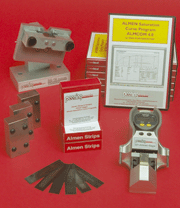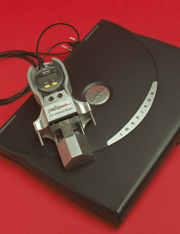E-Archive
Cover Page
in Vol. 4 - January Issue - Year 2003
The whole Range of Almen Products!


Peening Accessories GmbH is a German company and manufactures probably the most complete range of different Almen products. It has a warehouse in the USA as well as in Europe and a total of 18 international distributors.
Peening Accessories GmbH is not only offering worldwide probably the largest range of various Almen related products, but also introduces, depending on the item, a number of new features, which have not been available so far.
Who ever is involved in peening has to deal in one or the other way with the measurement of Almen intensities. The concept of this company was to manufacture any kind of product directly related to the measurement of peening intensities. So not just Almen strips and holders, but also different Almen gages and a software to generate the Almen saturation curve.
Since most of those products are very heavy, a warehousing in Europe and the USA was arranged. That in order to keep the shipment cost for the customer as low as possible. In addition, a global network of distributors in 18 countries insures that the customers have the shortest possible delivery time and can relay on a qualified technical support.
Almen Gages HP/INDUSTRIAL
The manufacturer has designed completely new Almen gages, trying to acknowledge the feedback received from many users around the world. Two different types are being introduced. A "All in One" HP Almen Gage, which is the high precision version. The second type is the Industrial Almen Gage, a lower budget gage which is not equipped with the automated "Zero" setting as well as the protective casing. However, all gages are digital. Designing Almen gages, a number of issues have to be addressed.
a) Almen Strip Position
A spring force will keep the strip in place. It is important that the spring force is applied excactely at the counter position where the 4 supporting balls of the Almen strip are placed. Doing so, it is mechanically impossible that the spring force can corrupt the reading. Unless the spring force is high enough to cause a plastic deformation of the strip material itself. But with the small spring force used in the design that is out of the question.
b) No permanent Magnets
Looking in general at a surrounding where accurate measurements within tolerances of .0001" (.001mm) take place, sometimes non permanent magnets are used to hold e.g. a measurement indicator in position. But to use a permanent magnet where measurements have to be made is certainly to be avoided. That is especially true around a peening machine where steel shot and metal residues are often if not always found. A permanent magnet to hold an Almen strip in position is just a constant source for false Arc height readings. Even if one tries to clean the strip surface and the gage. A small metal residue, maybe on the edge of the strip or the hand of the operator will be drawn to the magnet in an instant, once placed near it. And it has to be remembered that arc heights of .0001" (.001mm) resolution are measured! Therefore very tiny metal particles could cause a false reading. So looking at a completely new design of a gage, permanent magnets were out of the question for keeping the strip in position.
c) Support Balls made of Ceramic
Besides dirt and residues corrupting a reading, worn off support balls are probably the second largest source for false readings. The 4 balls which support the strip, show naturally signs of wear after a certain number of measurements. That of course changes the reading of the indicator since the position of the support balls is calibrated to the position of the indicator. Using support balls made of ceramic instead hardened ball bearing balls certainly reduces the wear to a great extent.
d) Automated Zero Setting
The flat zero setting block, which is needed for setting the indicator to "Zero" before the first measurement, has been integrated in the gage design. So a "Zero" setting is done automatically by switching the gage ON. In addition that system allows a visual "Zero" setting control before every measurement. However, this high end feature is just available at the "All in One" HP Almen gage.
e) Digital Indicator
No matter what type of gage, all gages come with a water resistant Swiss made digital indicator, designed for a resolution of 0.0001" (0.001mm). The indicators are equipped with an SPC interface for data output. Using a RS232 connection cable (USB on request) and the software HYPERTERMINAL, which comes with every WIN 95/98/2000/NT/XP version, the digital indicator of the “All in One” HP and INDUSTRIAL gage can be connected to the computer. Doing so, the arc height measurements can be transferred to the requested software.
(see picture on the right side)
f) Calibration Service for 2 Years
In most cases, either the working surrounding or specifications to be fulfilled require measurement devices to be re-calibrated once a year. So the manufacturer has its own calibration centre. It is not just the indicator itself which has to be calibrated. Also the 4 supporting balls, as well as their position to the indicator need to be checked. Since that is so important, Peening Accessories GmbH includes a 2 year free calibration service. Furthermore it offers loaner gages to customers who send in their gages.
Almen Strips
The crucial factor in terms of quality of strips is determined in the way the strips are manufactured. It is not just the fulfilment of certain hardness and flatness tolerances, but much more how the strips are processed. The strips have to be clamped during heat setting and tempering. That insures that the strip will be very flat and have equal residual stresses on both sides of the strip. However, some manufacturers of very cheap strips, perform a tempering of the steel while it is in the coiled roll state. The mechanical deformation or straightening is then executed at room temperature. Such a bending process puts a definite surface tensile stress into one side of the strip. Strips manufactured like this show a unusual strip performance. The SAE AMS 2432 Shot Peening Specification states "Mechanically deforming test strips to meet the flatness requirement is not permitted." For that reason such strips are banned by some of the most recognized companies in the Aviation industries.
Besides choosing the right manufacturing technique, simplifying the number of different strip types was an issue. Of course, there is still a need for A, N and C strip. However, Peening Accessories GmbH is just offering two qualities of each. A high precision flatness strip (0.0005"), which is the AERO strip and a so called INDUSTRIAL strip with a flatness of 0.0015". The streamed lined manufacturing process allowed the manufacturer to offer even the AERO strip to a highly competitive price.
Almen Holders for External and Internal Peening Applications
Besides the standard Almen strip holder according to SAE J442, which is hardened to Rockwell C 58, the company also manufactures an universal strip holder for internal peening. The so called model IN-19 is a free standing device with adjustable angle and over 30 hardened replacement blocks to represent the different hole diameters up to 19mm. It eliminates the need for costly and time consuming custom designed Almen strip holders (U.S. patent application no. 09/640.2002).
Almen Saturation Curve Program
The completely independent Almen saturation curve program (The PA² Software) will read out T and 2T, indicates faulty Arc height values as well as combine the information of up to 4 different Almen test series. Furthermore one can individually create its own protocol and save all the Almen curves on hard disk or print them out. It runs on any Windows (Win 95/98/2000/NT/XP) based computer. The software is the perfect aid for anyone using an Almen gage.
Peening Accessories GmbH
(Sales Office)
Tel.: +41.1.831 2644
Fax: +41.1.831 2645
E-mail: info@peeningaccessories.com
www.peeningaccessories.com



























